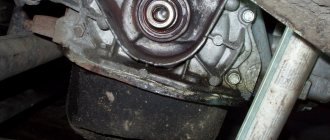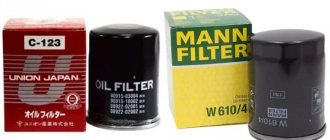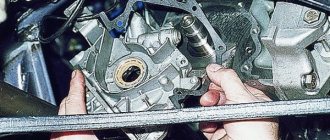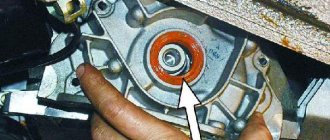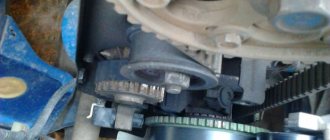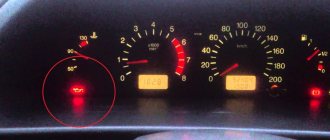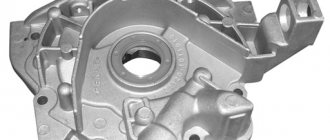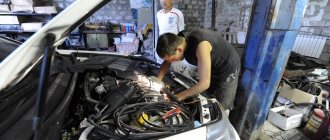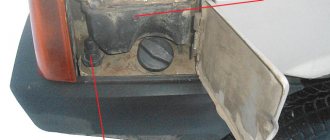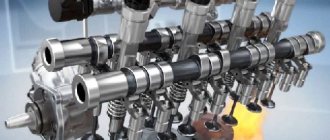The operation of the lubrication system of an internal combustion engine is possible only if all its structural elements are in good working order and coordinated action. Failure of at least one of its parts will inevitably lead to problems in the power unit.
In this article we will talk about what an oil pump pressure reducing valve is and what its functions are. We will also look at the operating principle of this lubrication system unit and tell you how to properly repair and adjust it.
Why do you need an oil pump pressure reducing valve?
As you know, oil is supplied to moving engine parts under a certain pressure created by a running pump. Without this, the lubricant would simply flow into the crankcase, exposing the elements of the crank and gas distribution mechanisms to increased friction and overheating. But too high a pressure is also dangerous for the engine. Gaskets, seals, seals are not able to withstand exceeding its normal values. Because of this, oil begins to ooze from under them, and can also enter the power and cooling system of the power unit.
It is to reduce the lubricant pressure in the system that the oil pump pressure reducing valve is designed. The word “reduction” itself is often used in mechanical engineering, denoting a reduction, reduction, or weakening of something. In our case, this refers to oil pressure.
Where is he located?
The oil pump pressure reducing valve is most often located on the cover of this device, which is located in the lower front part of the engine block behind the generator drive pulley. Sometimes it can also be installed on the oil filter housing.
There are two types of valves: built-in and detachable. In the first case, the oil pump and pressure relief valve are a single structure that cannot be disassembled. In the second, the pressure control mechanism is removed from the pump using a tool and can be repaired separately.
Operating principle of pressure reducing valve
The oil pressure in the system can depend on several factors, but the main one is the number of crankshaft revolutions. In other words, the harder we press the gas pedal, the faster the oil pump gears rotate. And the faster the gears rotate, the greater the volume of oil the pump captures from the crankcase, and the higher its pressure at the outlet.
When the pressure reaches a certain value, the serviceable valve opens slightly, allowing oil to pass into the reserve channel, through which the lubricant flows back into the crankcase.
The operation of the oil pump pressure reducing valve is as follows. The piston or metal ball is pressed against the inlet of the housing by a spring, which, in turn, is supported by a thrust screw. The oil, under the influence of increasing pressure, begins to put pressure on the surface of the valve, pushing it inside the body and compressing the spring. Thus, a hole opens, through which the lubricant goes into the reserve channel.
When the pressure decreases, its value is no longer sufficient to keep the valve in the open position, and the ball or piston, under the influence of a spring, again closes the inlet hole. As you can see, the scheme is quite simple and reliable, however, it sometimes fails.
Equipment classification
The oil pump and pressure maintenance valve have a certain classification according to their design. The pumps are:
- Adjustable;
- Unregulated.
In the adjustable version, constant pressure is maintained by changing the position of one of the pump parts. But the device of the unregulated version could not do without the use of a pressure reducing valve. Each of the options discussed above is divided according to the structure of the mechanism into gear and rotary.
In turn, oil pressure regulators are of hydraulic and pneumatic types, regardless of the type, both of them are designed to maintain pressure at a given level. Based on the power source, valves are of the following types:
- Reduction, controlled by a pneumatic drive;
- Electrically driven;
- Autonomous, not requiring a power source.
Now it’s time to consider the purpose and operating principle of the pressure reducing valve.
Valve Tasks
As already mentioned, the oil valve is necessary to maintain the pressure at a certain level. After the engine has started, the task of the pressure reducing valve is to stabilize the pressure and maintain the level throughout the entire period of engine operation.
If the pressure drops below the nominal level, this will mean that some engine parts will lose normal lubrication, and a breakdown will soon occur.
Reducing valve malfunctions
The pressure reducing valve, oil pump and oil filter are the main elements of the lubrication system, but if the latter, due to the peculiarities of its design, almost never breaks, but only becomes clogged, then the first two parts can fail quite often. The reason for this is usually the use of low-quality oil, lubricant that does not correspond to the type of engine and its operating conditions, as well as untimely replacement. In this case, particles of dirt, metal shavings or combustion products contained in the lubricant settle on the working surfaces of the valve, which, in fact, leads to its clogging and jamming.
Also, the cause of the malfunction can be a spring if it has stretched over time or, conversely, has compressed, bent, or burst.
It is immediately necessary to point out that repairing the oil pump pressure reducing valve is only possible if it has a collapsible design. For non-separable models, the entire pump cover will need to be replaced.
A valve is considered faulty if it is unable to maintain the required pressure in the system, and when its mechanism does not operate when the pressure reaches its maximum value. In the first case, it will not be difficult to determine the breakdown - a warning lamp on the car’s instrument panel will notify you about this. But you can only find out about the increase in pressure by oil leaks on the engine.
Instructions for verification
So:
- First, check the serviceability of the electrical circuit going from the sensor to the instrument panel
. Throw the wire going from the sensor to the engine to ground, the light will go out if the circuit is working properly. - The second reason could be the oil filter. Such a breakdown is determined by unscrewing the oil pressure sensor. It should be moistened with oil; a dry sensor means that the filter is clogged or its valve is stuck.
- When it does not work, open the pan and check the oil receiver itself and the condition of its rubber sealing ring.
- After these checks, one reason remains - a breakdown of the unit itself.
For your information:
- The engine of the VAZ 2110 model is equipped with a combined lubrication system. On machines of this model there is a gear oil pump, which is located at the front end of the cylinder block.
- Special gears with trochoidal internal gearing reduce mechanical losses during rotation.
- The oil pump itself is equipped with a fully in-line, non-separable filter. With bypass and anti-drainage valves. This device ensures good oil circulation and lubrication through all components of the internal combustion engine (ICE).
- It works by rotating the crankshaft. The connection method to the crankshaft is direct, which is typical for all VAZ cars with front-wheel drive.
- On all-wheel drive and classic models, the system is supplemented with special transmission parts: a timing chain, an intermediate shaft, and a set of gears that transmit torque from the crankshaft.
- The service life of this pump is from 120 thousand km, it works properly when the engine has already undergone a major overhaul. However, during operation, breakdowns are not excluded.
If replacement is still required, it is better for you to choose the VAZ 2110 oil pump from among reliable manufacturers.
Operating procedure
So:
- Disconnect the negative cable from the battery terminal.
- Drain the oil from the engine (through the drain plug in the oil pan).
- We take out the camshaft drive belt.
- Now remove the oil sump.
- On engines with a fuel injection system, disconnect the block with wiring from the sensor that counts crankshaft revolutions.
- Using two screwdrivers, remove the pulley from the crankshaft.
At what pressure should the pressure reducing valve operate?
But how can you understand that the pressure has increased or, conversely, decreased? And what should it even be like? The optimal oil pressure in the system can be found by looking at the owner's manual. It will be different for different brands and models of cars. For example, the pressure reducing valve of the Tavria oil pump operates at 0.55 MPa. Approximately the same indicators are relevant for most Lada cars.
You can measure oil pressure by connecting a special liquid pressure gauge to the system into the pressure sensor mounting socket. Before this, the engine must be warmed up to operating temperature. All measurements are made with the engine running.
Repair and adjustment of the oil pump pressure reducing valve
It is possible to understand whether the pressure reducing valve is suitable for further use only by dismantling it and disassembling it. This way it will be possible to diagnose all its elements. If there are deposits on the valve body, they must be washed off with gasoline, kerosene or carburetor cleaning fluid. It is also worth carefully inspecting the spring. If it shows signs of stretching, compression or deformation, it needs to be replaced.
When you have completely reassembled the valve, check its operation by simply pressing on the ball (piston). If it is pressed in with force and returns back, locking the housing channel, most likely the mechanism is working.
Adjustment of the oil pump pressure relief valve is carried out after the pressure relief valve is installed in the device body. The process is carried out by compressing or releasing the spring by unscrewing (twisting) the thrust screw. At the same time, oil pressure in the system is measured using a liquid pressure gauge. The adjustment, of course, is carried out with the engine not running, and the pressure measurement is carried out with the engine running.
Functions and structure of the filter element
The main material used to filter oil is a special multi-layer cellulose material that resembles paper. In its composition, in addition to modified cotton and cellulose fibers, glass fibers are pressed in, playing the role of a reinforcing lattice. The core of the material is reinforced with a special polymer. This paper is folded in a special way, increasing the filtration surface, into a single cartridge. Special perforated plates made of plastic or metal are glued to the end surfaces of the device, which help to properly distribute the oil flow.
In addition to paper options, a polymer microsponge resembling foam rubber is used. Unlike paper, the filtration surface of such a device is much higher and is capable of retaining a very wide range of particles and compounds. It must be said that such filter elements work great under conditions of regular engine flushing with timely oil changes. A running engine with a dirty lubrication system will quickly clog the sponge with dirt and varnish deposits. Next, the device will operate with an open bypass valve with minimal cleaning of the lubricant, which will reduce the service life of the motor.
Useful tips
Finally, here are some useful tips that may help you avoid problems with the oil pump pressure reducing valve or make it possible to identify its malfunction in time:
- Fill the engine only with high-quality motor oil of the appropriate type and viscosity grade. Lubrication requirements can be found in the vehicle manufacturer's recommendations.
- Never mix different brands of oils, even if they are of the same class.
- Change the oil and oil filter in a timely manner. The regulations for this procedure are also indicated in the car owner's manual.
- Do not allow dirt, moisture, or process fluids to enter the lubrication system.
- Monitor oil pressure. When the corresponding warning light on the device turns on, do not hesitate to go for diagnostics.
- Pay attention to the operating temperature of the engine. Overheating can cause coolant to enter the lubrication system.
- If you decide to replace or adjust the oil pump pressure relief valve without the necessary skills and tools, it is better to use the services of specialists.
Important points
There are a couple of nuances that you definitely need to remember when changing the oil pump:
- Before installing a new oil pump, you need to remove the plastic oil seal from it and generously lubricate its inner edge with engine oil. This will make it much easier to install the pump on the crankshaft;
- When the pump is completely seated on the shaft, do not immediately tighten the mounting bolts. First you need to tuck the edge of the above plastic seal inside. This should be done using a pointed stick or pencil. It is strictly not recommended to thread the oil seal with a flat screwdriver or a knife: it breaks very easily, and it is almost impossible to find it on sale.
Replacing the oil pump on VAZ 2114 and VAZ 2115 cars is a task that seems impossible only at first glance. Upon closer examination, it turns out that you can cope with it on your own, saving a significant amount on the services of a qualified auto mechanic.
Replacing the oil pump is necessary in the absence of operating pressure for full operation both under load and at idle. The oil pump must be replaced by placing the car in an inspection hole.
